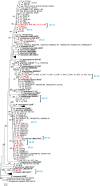Both Alpha- and Beta-Rhizobia Occupy the Root Nodules of Vachellia karroo in South Africa
- PMID: 31214140
- PMCID: PMC6558075
- DOI: 10.3389/fmicb.2019.01195
Both Alpha- and Beta-Rhizobia Occupy the Root Nodules of Vachellia karroo in South Africa
Abstract
Vachellia karroo (formerly Acacia karroo) is a wide-spread legume species indigenous to southern Africa. Little is known regarding the identity or diversity of rhizobia that associate with this plant in its native range in South Africa. The aims of this study were therefore: (i) to gather a collection of rhizobia associated with V. karroo from a wide range of geographic locations and biomes; (ii) to identify the isolates and infer their evolutionary relationships with known rhizobia; (iii) to confirm their nodulation abilities by using them in inoculation assays to induce nodules under glasshouse conditions. To achieve these aims, soil samples were collected from 28 locations in seven biomes throughout South Africa, which were then used to grow V. karroo seedlings under nitrogen-free conditions. The resulting 88 bacterial isolates were identified to genus-level using 16S rRNA sequence analysis and to putative species-level using recA-based phylogenetic analyses. Our results showed that the rhizobial isolates represented members of several genera of Alphaproteobacteria (Bradyrhizobium, Ensifer, Mesorhizobium, and Rhizobium), as well as Paraburkholderia from the Betaproteobacteria. Our study therefore greatly increases the known number of Paraburkholderia isolates which can associate with this southern African mimosoid host. We also show for the first time that members of this genus can associate with legumes, not only in the Fynbos biome, but also in the Albany Thicket and Succulent Karoo biomes. Twenty-six putative species were delineated among the 88 isolates, many of which appeared to be new to Science with other likely being conspecific or closely related to E. alkalisoli, M. abyssinicae, M. shonense, and P. tropica. We encountered only a single isolate of Bradyrhizobium, which is in contrast to the dominant association of this genus with Australian Acacia. V. karroo also associates with diverse genera in the Grassland biome where it is quite invasive and involved in bush encroachment. Our findings therefore suggest that V. karroo is a promiscuous host capable of forming effective nodules with both alpha- and beta-rhizobia, which could be a driving force behind the ecological success of this tree species.
Keywords: Acacia karroo; Bradyrhizobium; Paraburkholderia; South Africa; Vachellia karroo; alpha-rhizobia; beta-rhizobia.
Figures


Similar articles
-
Rhizosphere Diazotrophs and Other Bacteria Associated with Native and Encroaching Legumes in the Succulent Karoo Biome in South Africa.Microorganisms. 2022 Jan 20;10(2):216. doi: 10.3390/microorganisms10020216. Microorganisms. 2022. PMID: 35208671 Free PMC article.
-
Emergence of β-rhizobia as new root nodulating bacteria in legumes and current status of the legume-rhizobium host specificity dogma.World J Microbiol Biotechnol. 2020 Feb 24;36(3):40. doi: 10.1007/s11274-020-2811-x. World J Microbiol Biotechnol. 2020. PMID: 32095903 Review.
-
Mesorhizobium salmacidum sp. nov. and Mesorhizobium argentiipisi sp. nov. are symbionts of the dry-land forage legumes Lessertia diffusa and Calobota sericea.Antonie Van Leeuwenhoek. 2025 Feb 12;118(3):54. doi: 10.1007/s10482-025-02063-2. Antonie Van Leeuwenhoek. 2025. PMID: 39934476 Free PMC article. Review.
-
Delineation of Paraburkholderia tuberum sensu stricto and description of Paraburkholderia podalyriae sp. nov. nodulating the South African legume Podalyria calyptrata.Syst Appl Microbiol. 2022 May;45(3):126316. doi: 10.1016/j.syapm.2022.126316. Epub 2022 Mar 8. Syst Appl Microbiol. 2022. PMID: 35339818
-
Biogeographical Patterns of Legume-Nodulating Burkholderia spp.: from African Fynbos to Continental Scales.Appl Environ Microbiol. 2016 Aug 15;82(17):5099-115. doi: 10.1128/AEM.00591-16. Print 2016 Sep 1. Appl Environ Microbiol. 2016. PMID: 27316955 Free PMC article.
Cited by
-
Distribution, Characterization and the Commercialization of Elite Rhizobia Strains in Africa.Int J Mol Sci. 2022 Jun 13;23(12):6599. doi: 10.3390/ijms23126599. Int J Mol Sci. 2022. PMID: 35743041 Free PMC article. Review.
-
Synergy between Rhizobial Co-Microsymbionts Leads to an Increase in the Efficiency of Plant-Microbe Interactions.Microorganisms. 2023 May 4;11(5):1206. doi: 10.3390/microorganisms11051206. Microorganisms. 2023. PMID: 37317180 Free PMC article.
-
Changes in the rhizosphere and root-associated bacteria community of white Guinea yam (Dioscorea rotundata Poir.) impacted by genotype and nitrogen fertilization.Heliyon. 2024 Jun 15;10(12):e33169. doi: 10.1016/j.heliyon.2024.e33169. eCollection 2024 Jun 30. Heliyon. 2024. PMID: 39021943 Free PMC article.
-
Alien invasive Leucaena leucocephala successfully acquires nutrients by investing in below-ground biomass compared to native Vachellia nilotica in nutrient-amended soils in South Africa.AoB Plants. 2022 May 26;14(3):plac026. doi: 10.1093/aobpla/plac026. eCollection 2022 Jun. AoB Plants. 2022. PMID: 35747246 Free PMC article.
-
Rhizosphere Diazotrophs and Other Bacteria Associated with Native and Encroaching Legumes in the Succulent Karoo Biome in South Africa.Microorganisms. 2022 Jan 20;10(2):216. doi: 10.3390/microorganisms10020216. Microorganisms. 2022. PMID: 35208671 Free PMC article.
References
-
- Banfi E., Galasso G. (2008). “New combinations in Vachellia Wight & Arn., formerly Acacia Mill. ss (Fabaceae),” in Proceedings of the Atti della Società Italiana di Scienze Naturali e del Museo Civico di Storia Naturale di Milano Vol. 149 (Milan: ), 149–150.
LinkOut - more resources
Full Text Sources

